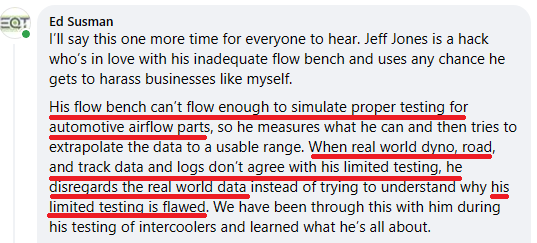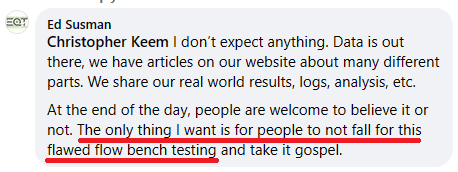Prologue:
I found the quote by Jonathan Swith about how quickly lies spread to be particularly pertinent to the matter discussed in this post.
Background:
Last week I made two posts where I discussed some erroneous information being given by two different people in separate discussions, but which contained the same misinformation.



I used the second post to discuss the erroneous claims, but neither commenter responded to my request to discuss their claims, so I didn’t have the chance to inquire about what their source was.
I presumed their claims were based upon what they had “heard from others” since both referenced things being done by other people.
Research:
Common to both discussions was the Blaze intake compared with other products, bench testing, and vehicle recorded data.
Connecting the dots led back to my look at the claims EQT makes for this intake, where I found them to be unsubstantiated, and I pointed this fact out to other enthusiasts.

On social media, the post generated a lot of discussions and in the responses I found the source of the disinformation:


The two enthusiasts above were repeating Ed Susman’s unsubstantiated claims almost verbatim four months after the original comments were made.
In Ed’s comments, he immediately changes the subject from the unsubstantiated product claim to making accusations about “inadequate flow benches“, “ignoring real-world data“, and “flawed testing“, which is an implementation of the Red Herring logical fallacy.
A red herring fallacy refers to an attempt to change the subject and divert attention from the original issue. In other words, a seemingly solid but ultimately irrelevant argument is introduced into the discussion, either on purpose or by mistake.
As a result, one can divert others’ attention away from the original discussion topic or avoid answering a difficult question.
Scribbr
The fact that Ed’s disinformation has become widespread is not too surprising, in the discussions that followed he repeated his claims over and over again to different people:



A noteworthy point about the statements Ed is making is the absence of substantiation. There are even instances such as the next statement where Ed claims that he “provided real world data” yet he doesn’t present the person with evidence to show that what he is claiming is true.

Here again, Ed claims that something was “shown” yet does not provide the person with any evidence to support his claim.





Conclusions:
Ed Susman, the owner of Equilibrium Tuning, is the source of disinformation that two enthusiasts repeated to me and several others.
Ed’s comments shown above are a good example of how to implement a “red herring” logical fallacy (deliberately trying to derail a discussion from the issue at hand to a new, unrelated topic.)

There are two noteworthy problems with Ed Susman’s words and actions:
The first is that Ed failed to address his business’s unsubstantiated product claims that can be misleading to consumers.
The second is that Ed made multiple unsubstantiated claims in an effort to discredit me, the work I have done, and the tools I have used in another effort to mislead consumers.
The words and actions of Ed Susman, which have misled consumers, illustrate the need for consumers to look for evidence when claims are made. Otherwise, falsehoods will fly.


EQT customer but it’s hard to respect behavior like this
I see many parallels between the EQT group and other online political groups. There’s a strong “groupthink” effect where if you don’t hold the same views as Dear Leader, you’re made to feel extremely unwelcome. You can’t really put forth a view that isn’t in line with the accepted rhetoric. I had to leave the group because of it.
This exchange led me to see the same parallels. Other ‘things’ that I’ve observed over the past couple of years also started to fit together. That it is happening on a subject like performance parts, which should be objective for the most part, is an indication of how convincing disinformation can be.
Society has an interesting affliction where many people would rather belong and “feel right,” than actually be right. It takes less effort to just repeat the same talking points that make you feel good, than to take the time to think critically and objectively. Too many people take that cop-out.
You can only Lead a horse to the water the rest is up to the horse
The concern here should be that EQT is the sole distributor for Blaze intakes and thus have a monumental vested interested in pushing them as a superior product.
They initially announced these intakes under an implied “These intakes are so good you need a re-tune!”, which is a win-win in all regards. Falsely pushing the intakes as vastly superior, and taking money for an additional tune modification.
I cannot count how many times I’ve seen workshops, hardware distributorships and in some case software vendors pushing an inferior/average product with false information along the same “SO GOOD WE HAD TO DO X” narrative. Usually it doesn’t work so great.
Unfortunately, EQT haven’t got a customer base, they’ve got a cult. You can sell anything ot these guys and they’ll parrot until the sun burns out.
Ed was wildly successful at convincing a large number of people that testing with the flow bench is flawed, along with other tests I’ve done. Just how gullible people were to this is buried in an exchange that happened during Ed’s posts trying to discredit me.

The flow testing has not contradicted data people have presented from their cars. They both show the intake has some potential for improvement, depending on what setup you started with.
People just believed what they were told in the “now hear this” announcement without thinking about it, but Ed knew my tests showed the Blaze intake is a decent product.
He killed it with the “red herring”. People went after that and are still believing it to this day.
Same…disappointing behavior when Jeff is geniunely helping the community out and shares the data freely. The whole thing leaves a bad taste in my mouth.
Agreed. The cult, borg mindset is also off putting. I would think a collaboration of testing and data sharing would only benefit the community.